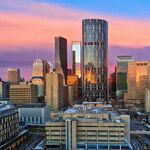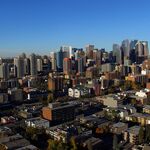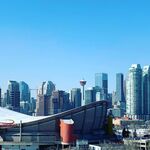I see far more often it's on the protected lanes that other bikers don't look. The lane makes things feel safer, except it's not much safer at intersections. I support protected lanes, I just wish more bikers are more careful for their own sakes, even if they shouldn't have to. Like if a dump truck is to your left approaching an intersection, you really should slow down and let them pass. Again, it's not the victim's fault as they shouldn't have to, but it's the reality of the situation unfortunately.
I could rant endlessly on this, but IMO we have a terribly limited approach for 'bike lanes' in the post-war suburbs. Main street projects are excellent and offer substantial upgrades to the 'last meters' for all active mobility users. But they are absolutely not an 'arterial' solution for cyclists to cover any significant distance.
Too many cars. Too many intersections. Too many ramps. Poor connections (what are you supposed to do SB on 37th beyond Richmond Rd?). And for the foreseeable future, too many closures! Which is a great sign of redevelopment, but something that we can expect continuously for decades to come.
Meanwhile we have a nearly perfect grid system of quiet side streets, with a decent network of pedestrian signals for crossing the busy streets. We have used simple wayfinding signs for decades on streets that are decent enough for cycling, and unsurprisingly the ped signals tend to be on these routes. It would not take much at all to improve these routes significantly, and stitch the network together: stop sign reversals, speed bumps, mini traffic circles, curb bump outs, and occasional diverters (cyclists can go straight but cars can't). No engagement necessary, and most of these have temporary versions that can be installed in an hour and trialled before investing permanently (which may not even be necessary).
Perhaps most importantly in this current climate, these things could all happen quietly and are not obviously part of the bike lane culture war BS. I think the challenge to this point has been that its harder to promote this while you're stitching it together piecemeal, compared to what we have been doing which lets us say "look, we're building stuff similar to Montreal and Denmark so now everyone can cruise around on beach cruiser bikes just like they do there!
21 vehicle crossings over 8 blocks/900 meters (as is the case on 26th Ave) is no problem if you're going at jogging speed!"
But if we built it quietly for a few years, then if/when the political climate allows we could be ready to promote a really good 'bike boulevard' network, and add enhance wayfinding, etc.

 calgary.citynews.ca
calgary.citynews.ca





